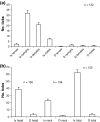Tick burden on European roe deer (Capreolus capreolus)
- PMID: 20099011
- PMCID: PMC2898109
- DOI: 10.1007/s10493-010-9337-0
Tick burden on European roe deer (Capreolus capreolus)
Abstract
In our study we assessed the tick burden on roe deer (Capreolus capreolus L.) in relation to age, physical condition, sex, deer density and season. The main objective was to find predictive parameters for tick burden. In September 2007, May, July, and September 2008, and in May and July 2009 we collected ticks on 142 culled roe deer from nine forest departments in Southern Hesse, Germany. To correlate tick burden and deer density we estimated deer density using line transect sampling that accounts for different detectability in March 2008 and 2009, respectively. We collected more than 8,600 ticks from roe deer heads and necks, 92.6% of which were Ixodes spp., 7.4% Dermacentor spp. Among Ixodes, 3.3% were larvae, 50.5% nymphs, 34.8% females and 11.4% males, with significant seasonal deviation. Total tick infestation was high, with considerable individual variation (from 0 to 270 ticks/deer). Adult tick burden was positively correlated with roe deer body indices (body mass, age, hind foot length). Significantly more nymphs were found on deer from forest departments with high roe deer density indices, indicating a positive correlation with deer abundance. Overall, tick burden was highly variable. Seasonality and large scale spatial characteristics appeared to be the most important factors affecting tick burden on roe deer.
Figures




Similar articles
-
Abundance estimation of Ixodes ticks (Acari: Ixodidae) on roe deer (Capreolus capreolus).Exp Appl Acarol. 2010 Sep;52(1):73-84. doi: 10.1007/s10493-010-9341-4. Epub 2010 Mar 4. Exp Appl Acarol. 2010. PMID: 20204470 Free PMC article.
-
Tick burden on European roe deer (Capreolus capreolus) from Saxony, Germany, and detection of tick-borne encephalitis virus in attached ticks.Parasitol Res. 2020 Apr;119(4):1387-1392. doi: 10.1007/s00436-020-06637-z. Epub 2020 Mar 24. Parasitol Res. 2020. PMID: 32211989
-
Tick infestation (Acari: Ixodidae) in roe deer (Capreolus capreolus) from northwestern Spain: population dynamics and risk stratification.Exp Appl Acarol. 2011 Apr;53(4):399-409. doi: 10.1007/s10493-010-9403-7. Epub 2010 Oct 21. Exp Appl Acarol. 2011. PMID: 20963472
-
[Ixodes ricinus, transmitted diseases and reservoirs].Parassitologia. 2004 Jun;46(1-2):119-22. Parassitologia. 2004. PMID: 15305699 Review. Italian.
-
Do roe deer (Capreolus capreolus) spread Borrelia-infected Ixodes ricinus ticks?Vet Q. 1996;18 Suppl 3:S146-7. doi: 10.1080/01652176.1996.9694720. Vet Q. 1996. PMID: 8933700 Review. No abstract available.
Cited by
-
Diverse tick-borne microorganisms identified in free-living ungulates in Slovakia.Parasit Vectors. 2018 Sep 3;11(1):495. doi: 10.1186/s13071-018-3068-1. Parasit Vectors. 2018. PMID: 30176908 Free PMC article.
-
Effect of landscape features on the relationship between Ixodes ricinus ticks and their small mammal hosts.Parasit Vectors. 2016 Jan 15;9:20. doi: 10.1186/s13071-016-1296-9. Parasit Vectors. 2016. PMID: 26767788 Free PMC article.
-
Red and fallow deer determine the density of Ixodes ricinus nymphs containing Anaplasma phagocytophilum.Parasit Vectors. 2021 Jan 19;14(1):59. doi: 10.1186/s13071-020-04567-4. Parasit Vectors. 2021. PMID: 33468215 Free PMC article.
-
Evidence for host specificity of Theileria capreoli genotypes in cervids.Parasit Vectors. 2017 Oct 10;10(1):473. doi: 10.1186/s13071-017-2403-2. Parasit Vectors. 2017. PMID: 29017556 Free PMC article.
-
Tick-Borne Pathogens in Ticks Collected from Wild Ungulates in North-Eastern Poland.Pathogens. 2021 May 11;10(5):587. doi: 10.3390/pathogens10050587. Pathogens. 2021. PMID: 34064818 Free PMC article.
References
-
- Andersen R, Duncan P, Linnell JDC. The European roe deer: the biology of success. Oslo: Scandinavian University Press; 1998.
-
- Buckland ST, Anderson DR, Burnham KP, Laake JL, Borchers DL, Thomas L. Introduction to distance sampling: estimating abundance of biological populations. Oxford, UK: Oxford University Press; 2001.
Publication types
MeSH terms
LinkOut - more resources
Full Text Sources
Miscellaneous

